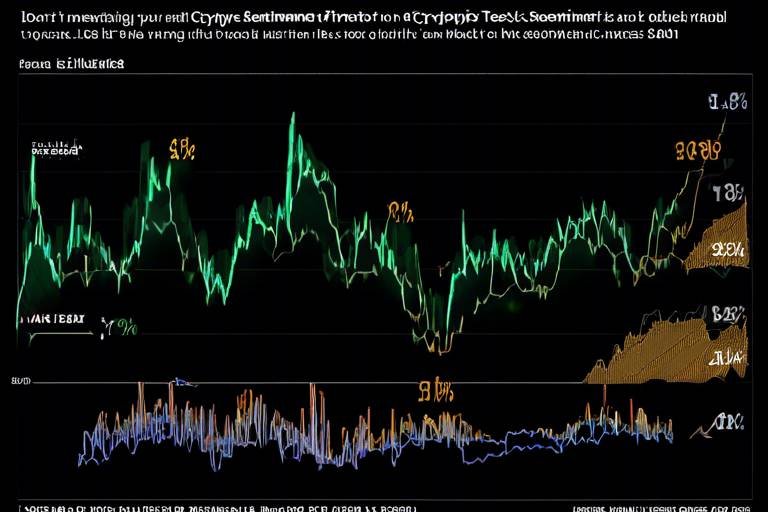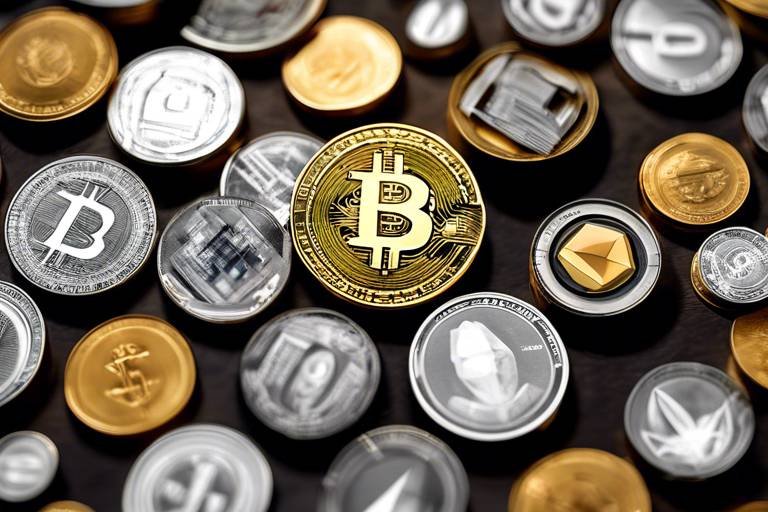The Impact of Market Sentiment on Crypto Prices
In the ever-evolving world of cryptocurrency, one factor stands out as a driving force behind price fluctuations: market sentiment. This elusive concept encapsulates the collective feelings and attitudes of investors towards digital assets, significantly influencing their trading decisions and, ultimately, the prices of cryptocurrencies. Understanding how market sentiment operates is crucial for anyone looking to navigate this volatile landscape, as it can lead to unexpected price surges or dramatic downturns. But what exactly is market sentiment, and how does it affect the crypto market?
Market sentiment is essentially the mood of the market, shaped by a multitude of factors including news, social media, and economic indicators. Imagine walking into a crowded room; the energy and emotions of the people around you can greatly influence your own feelings and decisions. Similarly, in the crypto market, the collective sentiment can create a ripple effect, impacting everything from individual trading choices to broader market trends. For instance, when positive news breaks about a major cryptocurrency, the sentiment can shift to an optimistic outlook, prompting more investors to buy in, thereby driving prices up. Conversely, negative news can trigger panic selling, leading to sharp declines.
As we delve deeper into the intricacies of market sentiment, we'll uncover the various elements that contribute to this phenomenon. From the influential role of social media to the psychological aspects of trading, each factor plays a vital role in shaping investor perceptions and behaviors. Understanding these dynamics is not just beneficial for seasoned traders; it's essential for anyone looking to make informed decisions in the crypto space.
Market sentiment refers to the overall attitude of investors toward a particular market or asset. In the cryptocurrency landscape, this sentiment can shift rapidly, making it both a fascinating and challenging aspect to monitor. The significance of market sentiment cannot be overstated; it acts as a barometer for potential price movements and can often predict trends before they become apparent through traditional analysis. Investors who grasp the nuances of market sentiment can position themselves advantageously, capitalizing on opportunities that others might overlook.
Several factors converge to shape market sentiment in the crypto world. Among the most impactful are:
- News Events: Breaking news, regulatory announcements, and technological advancements can sway investor emotions.
- Social Media: Platforms like Twitter and Reddit serve as echo chambers for opinions, amplifying sentiments rapidly.
- Market Trends: Historical data and patterns can influence current perceptions, leading to a herd mentality.
Each of these factors contributes to the emotional landscape of the market, creating a complex web of influences that traders must navigate.
Social media platforms have revolutionized the way information spreads, and their impact on market sentiment is profound. With just a tweet or a post, influential figures can sway public opinion, leading to significant price movements. For example, when a well-known investor expresses confidence in a particular cryptocurrency, it can lead to a surge in buying activity, as followers rush to capitalize on perceived opportunities. Conversely, negative comments can trigger sell-offs, illustrating the power of social media in shaping market dynamics.
In the crypto space, influencers play a pivotal role in shaping market sentiment. These personalities often have large followings and their opinions can carry substantial weight. When they share insights or predictions, it can lead to immediate reactions from their audience, influencing trading behaviors. For instance, consider a scenario where a prominent figure endorses a new altcoin; this could spark a buying frenzy, pushing the price to new heights.
Memes and viral trends are not just for laughs; they can significantly impact market sentiment as well. In the crypto community, humorous content often resonates with investors, creating a sense of camaraderie and shared experience. When a meme goes viral, it can lead to increased interest and investment in the subject of the meme, showcasing how humor can directly influence market dynamics.
Macroeconomic factors and breaking news events can drastically alter market sentiment. For instance, a positive jobs report or favorable economic outlook can instill confidence in investors, leading to increased investment in cryptocurrencies. Conversely, negative economic news can trigger fear and uncertainty, prompting sell-offs. Understanding how these indicators affect market sentiment is crucial for making informed trading decisions.
Investor psychology is a key player in the realm of market sentiment. Emotions such as fear and greed can heavily influence trading decisions, often leading to irrational behaviors. For example, during a market rally, the fear of missing out (FOMO) can drive investors to buy impulsively, while during downturns, fear can lead to panic selling.
The Fear and Greed Index is a popular tool used to gauge market sentiment. By measuring emotions and sentiments from different sources, this index provides insights into whether the market is in a state of fear or greed. Understanding this index can help investors make strategic decisions, allowing them to buy when others are fearful and sell when the market is overly greedy.
Herd behavior is another psychological aspect that significantly impacts market sentiment. When investors see others buying or selling, they often feel compelled to follow suit, leading to irrational market movements. This collective behavior can result in sharp price surges or declines, highlighting the importance of understanding the psychological factors at play in trading.
- What is market sentiment? Market sentiment refers to the overall attitude of investors toward a particular market or asset, which can significantly influence price movements.
- How does social media impact market sentiment? Social media platforms can amplify opinions and emotions, leading to rapid shifts in market sentiment and influencing trading behaviors.
- What is the Fear and Greed Index? The Fear and Greed Index is a tool that measures market sentiment by analyzing emotions and sentiments from various sources, helping investors gauge market conditions.

Understanding Market Sentiment
Market sentiment is like the pulse of the cryptocurrency world; it reflects the collective feelings, thoughts, and attitudes of investors towards a specific market or asset. Imagine walking into a room full of people, and you can instantly feel whether the atmosphere is tense or relaxed. In the same vein, market sentiment provides a snapshot of how investors feel about cryptocurrencies at any given moment. This sentiment can swing from extreme optimism, where everyone is bullish and prices soar, to sheer panic, where fear takes over and prices plummet. Understanding this emotional landscape is crucial for anyone involved in trading or investing in cryptocurrencies.
In the volatile world of cryptocurrencies, where prices can change in the blink of an eye, market sentiment serves as a significant indicator of potential price movements. For instance, when a major cryptocurrency exchange announces a new partnership, the market sentiment may shift positively, leading to increased buying activity. Conversely, negative news, such as regulatory crackdowns or security breaches, can send investors running for the exits. This ebb and flow of sentiment is not just a passing phase; it has tangible implications for market dynamics and investment strategies.
To grasp the full impact of market sentiment, it's essential to recognize its significance in shaping investor behavior. Factors such as social media buzz, economic indicators, and even memes can dramatically alter how investors perceive the market. For example, a trending hashtag on Twitter can spark a buying frenzy, while a viral meme could lead to a sudden sell-off. By understanding these elements, traders and investors can better navigate the unpredictable waters of cryptocurrency.
Moreover, market sentiment can be quantified using various tools and indices. One popular method is the Fear and Greed Index, which gauges the emotions driving market behavior. This tool provides insights into whether the market is overly greedy or fearful, helping investors make informed decisions. By analyzing market sentiment, investors can identify potential entry and exit points, ultimately enhancing their trading strategies.
In summary, understanding market sentiment is not just about keeping an eye on prices; it's about tapping into the emotions and psychology that drive those prices. By recognizing the factors that influence sentiment and the implications it has for trading, investors can position themselves more strategically in this ever-evolving market.

Factors Influencing Market Sentiment
Market sentiment is not just a whimsical notion; it's a powerful force that can dictate the rise and fall of cryptocurrency prices. Understanding the factors that influence this sentiment is crucial for investors and traders alike. One of the primary drivers is news events. Whether it's a major technological breakthrough, regulatory changes, or security breaches, news can create waves of emotion that ripple through the market. For instance, a positive announcement about a blockchain partnership can send prices soaring, while a negative report about hacking can trigger panic selling.
Another significant factor is the role of social media. Platforms like Twitter and Reddit have transformed how information spreads in the crypto space. Imagine a tweet from a well-known influencer declaring their support for a new coin; it can lead to a buying frenzy within minutes. Conversely, negative sentiments expressed on these platforms can lead to rapid sell-offs. The immediacy of social media means that market sentiment can shift almost overnight, making it essential for traders to stay informed and engaged.
Moreover, economic indicators play a vital role in shaping investor sentiment. Traditional financial metrics such as inflation rates, employment statistics, and interest rates can influence how investors perceive the stability and potential of cryptocurrencies. For example, if inflation rates are rising, investors might flock to crypto as a hedge against currency devaluation, boosting prices. On the other hand, if economic indicators suggest a downturn, it could lead to a more cautious approach among investors, impacting overall market sentiment.
Additionally, market trends and historical data can provide insight into how sentiment shifts over time. Traders often look at past price movements to predict future behavior. For example, if a particular cryptocurrency has shown a pattern of recovery after a sharp decline, investors may feel more confident in buying during dips, believing that the market will rebound. This kind of analysis helps create a self-fulfilling prophecy where sentiment drives price movements based on historical patterns.
Lastly, the collective behavior of investors cannot be overlooked. The psychological aspect of trading means that emotions such as fear and greed can lead to herd behavior, where individuals make decisions based on what others are doing rather than their own analysis. This phenomenon can create significant volatility in the market, as a sudden rush to buy or sell can lead to dramatic price changes. Understanding these dynamics is crucial for anyone looking to navigate the often tumultuous waters of cryptocurrency trading.
In summary, the factors influencing market sentiment are multifaceted and interconnected. From news and social media to economic indicators and collective behavior, each element plays a role in shaping how investors perceive the market. By staying informed and understanding these influences, traders can better position themselves to make strategic decisions in this ever-evolving landscape.

The Role of Social Media
In today's digital age, social media has become the heartbeat of communication and information dissemination, especially in the dynamic world of cryptocurrency. Platforms like Twitter, Reddit, and Telegram are not just social networks; they are powerful tools that shape market sentiment and influence investor behavior. When news breaks, or a trending topic emerges, the ripple effect can be felt across the entire crypto market within minutes. Imagine a pebble dropped into a pond—the ripples spread far and wide, impacting everything in their path. This is exactly how social media operates in the crypto world.
On platforms like Twitter, hashtags become rallying cries for the crypto community. A single tweet from a well-known figure can send prices soaring or crashing. For instance, when Elon Musk tweets about Dogecoin, the price can skyrocket within hours, demonstrating the profound impact that a single voice can have in this space. It's not just about the message; it's about the reach and the emotional resonance it carries with the audience.
Reddit, on the other hand, serves as a forum for in-depth discussions and community building. Subreddits like r/CryptoCurrency and r/Bitcoin are treasure troves of information, where users share insights, predictions, and memes. The collective intelligence of these communities can lead to significant price movements as traders act on the prevailing sentiment. In many ways, these platforms act like a barometer for market sentiment, where the mood can shift from euphoria to panic in a matter of hours.
Moreover, the role of influencers in crypto cannot be overstated. These are individuals or entities with a substantial following who can sway public opinion and investor decisions. Their endorsements can create a sense of legitimacy around a cryptocurrency, while their criticisms can lead to a swift decline in interest and investment. For example, when a respected analyst shares a bullish outlook on a particular token, it often leads to increased buying pressure, as followers rush to capitalize on the perceived opportunity.
However, it’s essential to approach social media with a critical eye. The same platforms that provide valuable insights can also spread misinformation. FOMO (Fear of Missing Out) and FUD (Fear, Uncertainty, Doubt) are rampant in the crypto space, often fueled by misleading posts or sensational headlines. Therefore, it’s crucial for investors to verify information and not let emotions drive their trading decisions. In the world of crypto, being well-informed is just as important as being active on social media.
In summary, social media plays a pivotal role in shaping market sentiment in the cryptocurrency landscape. From influencing price movements to fostering community discussions, its impact is undeniable. As an investor, understanding this dynamic can equip you with the insights needed to navigate the volatile waters of crypto trading effectively.
- How does social media affect cryptocurrency prices? Social media can influence prices by spreading information quickly, whether it's positive news that drives prices up or negative news that causes declines.
- What platforms are most influential in the crypto space? Twitter and Reddit are among the most influential platforms, with Twitter being used for real-time updates and Reddit serving as a hub for community discussions.
- Can I trust the information I find on social media regarding cryptocurrencies? While social media can provide valuable insights, it's essential to verify information from reliable sources to avoid falling prey to misinformation.

Influencers and Their Impact
In the ever-evolving world of cryptocurrency, the power of influencers cannot be overstated. These individuals, often with large followings on platforms like Twitter and YouTube, wield significant influence over market sentiment and can cause dramatic shifts in cryptocurrency prices with a single tweet or video. Think of them as modern-day oracles; their words can inspire waves of buying and selling that ripple through the market. But what exactly makes these influencers so impactful?
Firstly, it's essential to recognize that influencers often serve as trusted sources of information for many investors. In a market filled with complexity and uncertainty, the insights shared by these figures can simplify decision-making for traders and investors alike. When a well-known figure endorses a particular cryptocurrency or shares bullish sentiments, it can lead to a surge in interest and investment. Conversely, negative comments can trigger panic selling, demonstrating just how fragile market sentiment can be.
Moreover, the emotional connection that followers have with these influencers plays a crucial role in their impact. Many investors view these personalities as mentors or guides, leading them to trust their opinions implicitly. This trust can create a feedback loop where positive sentiments lead to increased buying, further validating the influencer's position and leading to even more significant price movements. For instance, when Elon Musk tweets about Dogecoin, the price often skyrockets, showcasing the direct correlation between influencer activity and market dynamics.
To illustrate this influence further, consider the following table that highlights some prominent influencers and their notable impacts on the crypto market:
| Influencer | Platform | Notable Impact |
|---|---|---|
| Elon Musk | Dogecoin price surged by over 300% after tweets | |
| Vitalik Buterin | Ethereum price fluctuations following announcements | |
| Andreas Antonopoulos | YouTube | Increased interest in Bitcoin through educational content |
In addition to individual influencers, entire communities can also shape market sentiment. Platforms like Reddit have become breeding grounds for collective trading strategies, where users rally around certain cryptocurrencies, often driving prices higher through coordinated buying efforts. This phenomenon showcases the power of social proof; when a large group of people is excited about a particular asset, others are likely to join in, further amplifying the price movement.
However, it's crucial to approach influencer-driven market movements with caution. The volatility of the crypto market means that prices can swing wildly based on sentiment alone, often leading to situations where investors may find themselves caught in a bubble. Therefore, while influencers can provide valuable insights and drive interest, it's essential for investors to conduct their own research and remain vigilant against the risks associated with following trends blindly.

Memes and Viral Trends
In today's digital age, memes and viral trends have become more than just a source of entertainment; they are powerful tools that can significantly influence market sentiment in the cryptocurrency world. Imagine a simple meme of a Shiba Inu dog skyrocketing the value of a coin overnight—this is the kind of phenomenon that showcases the unpredictable nature of crypto markets. Memes can encapsulate complex ideas and emotions in a way that resonates with the masses, leading to a collective reaction that can propel prices up or down.
When a meme goes viral, it often sparks conversations on social media platforms, drawing in both seasoned investors and curious newcomers. The rapid spread of these memes can create a bandwagon effect, where people rush to invest in a particular cryptocurrency simply because they see others doing so. This is where the psychology of trading intersects with the world of memes. For instance, a meme that humorously depicts a certain coin as the "next big thing" can create a buzz that leads to a surge in buying activity, often driven by FOMO (Fear of Missing Out).
The impact of memes is not just limited to social media chatter; they can also affect trading volumes and market stability. When a meme captures public attention, it can lead to significant price movements. For example, during the rise of Dogecoin, memes played a crucial role in its popularity, transforming it from a joke into a legitimate contender in the crypto space. This transformation was fueled by users sharing memes that highlighted its community and potential, creating a sense of belonging among investors.
Moreover, the role of influencers in this meme-driven market cannot be overlooked. Many key figures in the crypto community leverage their platforms to share memes, which can amplify their reach and impact. When an influencer posts a meme about a specific cryptocurrency, their followers are likely to engage, share, and invest, thus creating a ripple effect that further escalates the trend.
To illustrate the relationship between memes and market trends, consider the following table that highlights some notable examples:
| Meme | Cryptocurrency | Impact on Price |
|---|---|---|
| Shiba Inu Doge | Shiba Inu (SHIB) | Increased by over 1,000% within weeks |
| Doge to the Moon | Dogecoin (DOGE) | Surged past $0.70 during peak meme frenzy |
| Pepe the Frog | Various Altcoins | Created hype, leading to short-term price spikes |
In conclusion, memes and viral trends are not just playful distractions; they are integral components of the cryptocurrency market that can sway investor sentiment dramatically. As the crypto landscape continues to evolve, understanding the power of memes will be essential for anyone looking to navigate this volatile environment. The next time you come across a meme about a cryptocurrency, remember that it could be more than just a laugh—it might be a signal of the market's next big move!
- How do memes influence cryptocurrency prices? Memes can create hype and emotional responses among investors, leading to increased buying or selling activity based on trends.
- Can a meme cause a cryptocurrency to crash? Yes, if a meme portrays a negative sentiment or leads to panic selling, it can result in a significant price drop.
- Are all memes equally impactful? No, the impact of a meme depends on its reach, the influencers involved, and the current market conditions.

Economic Indicators and News Events
When it comes to the world of cryptocurrencies, the phrase "news travels fast" takes on a whole new meaning. Economic indicators and news events can act like a lightning bolt, striking at the heart of market sentiment and causing prices to fluctuate dramatically. Imagine the crypto market as a giant ocean; economic news is like a sudden storm that can create waves of volatility, pushing prices up or down in a matter of moments. Investors must stay vigilant, as the tides of sentiment can change with the latest headlines.
Economic indicators, such as inflation rates, employment statistics, and GDP growth, serve as the pulse of the economy, and their release can trigger significant reactions in the crypto market. For instance, if a country reports a higher-than-expected inflation rate, it could lead to fears about currency devaluation, prompting investors to flock to cryptocurrencies as a hedge. Conversely, positive economic news might encourage investors to take risks, driving prices higher.
Moreover, news events—ranging from regulatory announcements to technological breakthroughs—can create ripples that reverberate throughout the crypto community. For example, when a major country announces plans to regulate cryptocurrencies, it can send shockwaves through the market, leading to panic selling or, conversely, a surge in buying as traders speculate on the long-term implications. The unpredictable nature of news means that investors need to be prepared for anything.
To illustrate the impact of economic indicators and news events, consider the following table that highlights key events and their effects on cryptocurrency prices:
| Date | Event | Impact on Crypto Prices |
|---|---|---|
| January 2023 | US Inflation Rate Surges | Bitcoin Price Rises by 15% |
| March 2023 | Major Exchange Hack | Ethereum Price Drops by 20% |
| June 2023 | Regulatory Framework Announced in EU | Market Stabilizes, Prices Increase |
| August 2023 | Positive Employment Data Released | Altcoins Surge by 10% |
In summary, the interplay between economic indicators and news events creates a complex web of factors that can influence market sentiment and, ultimately, cryptocurrency prices. As an investor, keeping an eye on these elements is crucial for making informed decisions. Understanding that the market is not just driven by numbers and trends, but also by the emotions and reactions of its participants, can provide a strategic advantage in navigating this volatile landscape.
- What are economic indicators?
Economic indicators are statistical metrics that provide insights into the economic performance of a country, such as GDP, unemployment rates, and inflation rates. - How do news events affect cryptocurrency prices?
News events can create immediate reactions in the market, leading to price surges or drops based on the sentiment they generate among investors. - Why is market sentiment important in crypto trading?
Market sentiment reflects the collective emotions and attitudes of investors, which can significantly influence price movements in the highly volatile crypto market.

Psychological Aspects of Trading
When it comes to trading in the cryptocurrency market, understanding the psychological aspects is just as crucial as grasping the technical fundamentals. The crypto market is notorious for its volatility, and this volatility often amplifies emotional responses from investors. Have you ever noticed how fear or excitement can lead to impulsive decisions? This is where the concept of behavioral finance comes into play. Behavioral finance studies how psychological factors influence financial decision-making, and in the realm of crypto, it can be a game-changer.
One of the most significant emotional drivers in trading is the fear of missing out (FOMO). Imagine seeing your friends rave about a cryptocurrency that has skyrocketed in value overnight. You might feel the urge to jump in, even if the price seems inflated. This impulsive behavior can lead to buying high and selling low, a classic trap for many traders. Conversely, the fear of losing money can paralyze decision-making, causing traders to hold onto losing positions far longer than they should. It's a psychological tug-of-war that can wreak havoc on one's trading strategy.
Another critical psychological aspect is the Herd Behavior. In a market driven by social sentiment, it’s easy to see how collective emotions can sway individual decisions. When everyone is bullish and prices are rising, it’s tempting to follow the crowd. However, this herd mentality can lead to irrational market movements. For example, during a bull run, a trader might feel compelled to invest heavily because "everyone else is doing it." Yet, when the tide turns, and panic sets in, the same trader might sell at a loss, succumbing to the emotional pressure of the moment.
The Fear and Greed Index is a valuable tool that traders can use to gauge market sentiment. This index measures emotions and sentiments from different sources, providing a snapshot of whether the market is in a state of fear or greed. Understanding where the market stands on this index can help traders make more informed decisions. For instance, if the index indicates extreme fear, it may present a buying opportunity, while extreme greed could signal a time to sell. It’s all about timing and emotional intelligence.
To summarize, the psychological aspects of trading in the cryptocurrency market are profound and multifaceted. Recognizing the influence of emotions, understanding behavioral finance principles, and utilizing tools like the Fear and Greed Index can empower traders to make more rational decisions. By acknowledging these psychological factors, investors can navigate the tumultuous waters of the crypto market with greater confidence and clarity.
- What is the Fear and Greed Index?
This index measures market sentiment based on various factors, helping traders understand whether the market is predominantly fearful or greedy. - How can psychological factors affect trading decisions?
Emotions like fear and greed can lead to impulsive decisions, causing traders to buy high and sell low, impacting overall trading performance. - What is herd behavior in trading?
Herd behavior refers to the tendency of investors to follow the crowd, which can lead to irrational market movements and increased volatility.

Fear and Greed Index
The is a fascinating tool that captures the emotional pulse of the cryptocurrency market. Think of it as a mood ring for investors, reflecting their collective feelings of fear or greed at any given moment. This index ranges from 0 to 100, where a score of 0 indicates extreme fear and a score of 100 signifies extreme greed. But why does this matter? Well, understanding the sentiment behind these numbers can provide invaluable insights into potential market movements.
At its core, the Fear and Greed Index is based on several key factors that drive investor emotions. These include:
- Volatility: Sudden price swings can create panic or excitement.
- Market Momentum: The general trend of market prices can influence investor sentiment.
- Social Media Sentiment: Public discussions and trends on platforms like Twitter and Reddit can sway opinions.
- Surveys: Direct feedback from investors about their feelings towards the market.
- Google Trends: Search interest in cryptocurrencies can indicate growing or waning enthusiasm.
When the index leans towards fear, it often signals a potential buying opportunity. Investors may be overly pessimistic, leading to undervalued assets. Conversely, when the index indicates extreme greed, it might be a warning sign that a market correction is on the horizon. As a savvy investor, leveraging this index can help you make informed decisions, avoiding the pitfalls of emotional trading.
However, it’s essential to remember that the Fear and Greed Index is not a crystal ball. While it provides a snapshot of market sentiment, it should be used in conjunction with other analytical tools and personal judgment. After all, the crypto market is notoriously volatile, and emotions can shift rapidly. Keeping an eye on this index can help you stay grounded amidst the chaos, ensuring that your investment strategy remains robust and well-informed.
In summary, the Fear and Greed Index is more than just a number; it’s a reflection of the collective psyche of crypto investors. By understanding its implications and integrating it into your trading strategy, you can navigate the unpredictable waters of cryptocurrency with greater confidence.
- What does a low Fear and Greed Index indicate? A low index suggests that investors are fearful, which may present buying opportunities.
- How often is the Fear and Greed Index updated? The index is typically updated daily to reflect the latest market conditions.
- Can the Fear and Greed Index predict market crashes? While it can provide insights into sentiment, it cannot definitively predict market crashes.

Herd Behavior in Crypto Trading
In the thrilling world of cryptocurrency trading, herd behavior is a phenomenon that can lead to dramatic price fluctuations. Imagine a flock of birds suddenly changing direction; that’s how traders often react when they see others making moves. When a significant number of investors buy or sell a particular cryptocurrency, it creates a ripple effect that can sway the entire market. This behavior is not just a quirk of human nature; it's deeply rooted in our psychology. We are social creatures, and the desire to conform can often override our better judgment.
One of the most striking examples of herd behavior in the crypto market occurred during the massive price surge of Bitcoin in late 2017. As prices soared, more and more people jumped on the bandwagon, driven by fear of missing out (FOMO). This led to a classic bubble, where prices reached unsustainable levels, only to crash spectacularly shortly thereafter. The cycle of buying and selling based on what others are doing can create a feedback loop that amplifies volatility. Traders often find themselves caught in the whirlwind, reacting to market movements rather than making rational decisions based on their own analysis.
The impact of herd behavior can be seen in various ways, including:
- Price Surges: When many traders buy into a cryptocurrency simultaneously, prices can skyrocket, creating an illusion of stability and growth.
- Market Crashes: Conversely, if a significant number of investors decide to sell, it can lead to a rapid decline in prices, often exacerbated by panic selling.
- Increased Volatility: Herd behavior contributes to the overall volatility of the crypto market, making it a rollercoaster ride for investors.
Understanding herd behavior is crucial for anyone looking to navigate the crypto landscape successfully. It’s essential to recognize when you’re being influenced by the crowd and to develop a strategy that prioritizes personal analysis over collective sentiment. Tools like the Fear and Greed Index can help you gauge market sentiment and avoid getting swept up in the frenzy. By staying informed and maintaining a level head, you can make more calculated decisions that align with your investment goals.
In summary, herd behavior is a powerful force in crypto trading that can lead to both spectacular gains and devastating losses. By understanding this phenomenon, traders can better equip themselves to face the unpredictable nature of the cryptocurrency market, making decisions that are informed and strategic rather than reactionary.
- What is herd behavior in crypto trading?
Herd behavior refers to the tendency of investors to follow the actions of a larger group, often leading to significant price movements in the market. - How can I avoid falling into herd behavior?
To avoid herd behavior, focus on developing your own trading strategy based on thorough research and analysis rather than simply following the crowd. - What role does psychology play in trading?
Psychology plays a critical role in trading, as emotions like fear and greed can heavily influence decision-making processes. - Can herd behavior lead to market bubbles?
Yes, herd behavior can contribute to the formation of market bubbles, as collective buying can inflate prices beyond their intrinsic value.
Frequently Asked Questions
- What is market sentiment in cryptocurrency?
Market sentiment refers to the overall attitude and feelings of investors towards a specific cryptocurrency or the market as a whole. It captures the emotions and psychological factors that drive buying and selling decisions, influencing price movements.
- How does social media affect market sentiment?
Social media platforms like Twitter and Reddit play a significant role in shaping market sentiment. They serve as channels for news, opinions, and discussions that can rapidly influence investor behavior and market trends, often leading to sudden price changes.
- What role do influencers play in cryptocurrency markets?
Influencers in the crypto space can have a massive impact on market sentiment. Their endorsements or criticisms can sway public opinion, leading to increased buying or selling pressure based on their perceived authority and reach within the community.
- How do memes and viral trends influence crypto prices?
Memes and viral trends can capture the public's imagination, often leading to increased interest and investment in certain cryptocurrencies. This lighthearted content can boost investor confidence or create FOMO (fear of missing out), driving prices up or down.
- What economic indicators should I watch for in crypto trading?
Key economic indicators, such as inflation rates, employment statistics, and interest rates, can significantly impact market sentiment. Staying informed about these factors can help investors anticipate potential price movements in cryptocurrencies.
- What is the Fear and Greed Index?
The Fear and Greed Index is a tool that gauges market sentiment by measuring emotions like fear and greed among investors. It can provide insights into whether the market is overbought or oversold, helping traders make informed decisions.
- Why is herd behavior a concern in crypto trading?
Herd behavior occurs when investors follow the crowd rather than making independent decisions. This can lead to irrational market movements, causing prices to surge or plummet based on collective emotions rather than fundamental analysis, which can destabilize the market.
- How can I use market sentiment to guide my trading strategy?
Understanding market sentiment can help you make better trading decisions. By analyzing social media trends, economic news, and psychological indicators like the Fear and Greed Index, you can identify potential entry and exit points for your trades.



















